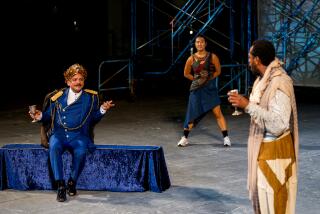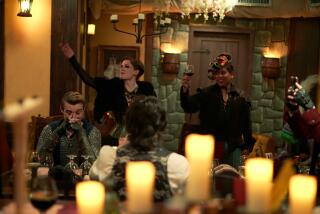In search of a wizard
Think of your favorite movie Merlin: Was it Sam Neill’s Tolkienesque version (see photo) or was it “Excalibur’s” Nicol Williamson, with that unforgettable steel skullcap? How about Stephen Dillane’s blue-faced portrayal in the 2004 box office disappointment “King Arthur”? (The movie didn’t disappoint me, Keira Knightley was in it.)
Adam Ardrey would have none of them, and very little of all the other Arthuriana that’s out there -- not T.H. White’s “The Once and Future King,” not Tennyson’s “Idylls of the King,” Thomas Malory’s epic, “Le Morte D’Arthur,” not even Marion Zimmer Bradley’s “The Mists of Avalon.”
The author of “Finding Merlin: The Truth Behind the Legend of the Great Arthurian Mage” (The Overlook Press: 384 pp., $24.95) would say that any adult interested in these inventions must be emotionally trapped in junior high. Oh, and they’ve probably also participated (at least once) in one of those silly medieval warfare reenactments.
Excuse me while I adjust my chain-mail pants.
And yet, above his clear distaste for the popular versions of this legend -- and he doles out plenty of this in his new book -- there is a fascinating question which he pursues with zeal: Just who was Merlin, really?
The answer Ardrey’s book provides is that the real Merlin was something of a scientist and Druid leader who helped the Scots and Britons fight off the Angles in the aftermath of Roman occupation. For his efforts, though, Ardrey says Merlin’s contributions were written out of early English chronicles or, when he is found, he is reduced to an insulting form -- a wildman or a madman of some kind.
In the Arthurian myths, Merlin was “neutered and presented as Arthur’s avuncular counsellor, the progenitor of fictional characters such as Gandalf, Obi-Wan Kenobi and Professor Dumbledore,” Ardrey declares. “I found he was none of these things but a scholar, a politician and a commander-in-chief who lived in central Scotland. . . . “ Then, he delivers a bombshell:
“When the motives and methods of writers like Thomas Malory and Geoffrey [of Monmouth] are recognised and the propaganda they were bound to present in the interests of commercial success and to please their patrons are stripped away, it is possible to see Merlin and Arthur as they were, as real men of sixth-century Scotland.”
The historical Arthur, according to Ardrey, was Arthur Mac Aedan, a daring warrior (and son of a powerful Scottish warlord) whose life and battles fit the time period of the late 6th century when many believe the real Arthur lived. (Arthur and his fabled kingdom will be the subjects of two forthcoming books by Ardrey -- “Finding Arthur” and “Finding Camelot.”) It is not difficult to understand why Ardrey’s argument is controversial: There’s enormous irony in saying that the sources of two key figures in a bedrock English tradition are Scotsmen.
The author’s foray into this subject was the unexpected result of a personal search -- to trace his family’s lineage in a Scottish clan. Ardrey draws on a variety of texts and fragments probably unfamiliar to even the most enthusiastic Arthurites -- the “Black Book of Carmarthen,” “The Life of Kentigern,” “Dialogue Between Myrddin and His Sister” and many others. In this book, he applies as rigorous an exegesis as you might find in John Meier’s scholarship on the historical Jesus.
In the process, what emerges in “Finding Merlin” is a fascinating picture of the British Isles after the Romans: “The island the Romans left behind was a patchwork of Celtic peoples, Britons who had lived for centuries under the protection of the Romans, and Scots and Picts who had freely bumped about the edges of the Empire.” With the weight of one oppressive force removed, however, the many diverse kingdoms and tribes erupted into civil war. It’s no wonder novelist John Cowper Powys (in a preface to Overlook Press’ reissue of his “Porius” last year) called that time period “an absolute blank, as far as documentary evidence goes.” Who had time to write down anything?
And yet, Ardrey fills this “absolute blank” by means of bold speculations and a chronology of Merlin’s life pieced from glimpses of him in the works of bards and chroniclers. Names are important to Ardrey’s method: “Merlin,” for instance, he says is a Gallic adaptation of “Myrddin,” a slur which Christian writers used to belittle Merlin’s old (read: pagan) ways. Ardrey says the insult derives from “Mer-duine,” meaning “madman.” “Merlin,” on the other hand, was preferred by the French for a simple reason: “Myrddin” sounded too much like the French word for defecation.
As Ardrey suggests, during the unrest of the 5th and 6th centuries, strong warlords like Emrys and Gwenddolau tried to create stability even though their alliances with people of “the Old Ways” made clashes with the Catholic Church inevitable. They were not kings, however, and could not have royal titles: Instead, their authority was indicated by the martial term “pendragon” or “chief dragon.” When Arthur’s father, according to Geoffrey, is said to be Uther Pendragon, Ardrey argues that Monmouth simply mistook “pendragon” for an individual’s name. And where did “Uther” come from? If Emrys was the first “pendragon,” the author says, then Gwenddolau was the other pendragon -- in Scottish “other” becomes “uthyre.”
This is fascinating stuff. So is Ardrey’s portrayal of Merlin as an important ally of Gwenddolau: That pendragon’s consolidation of power was feared -- even though, for his part, Gwenddolau pursued diplomacy, not continuous war. Ardrey charts Merlin’s fortunes as they rose and fell, and also those of his sister, Languoreth, whom Ardrey says was a woman of considerable power and influence. As with every other non-Christian, however, she lost everything with the arrival of Christianity. St. Kentigern figures in Ardrey’s narrative as an archenemy of Merlin, his sister and anyone else rejecting Christianity.
In describing the pagan-Christian conflict, Ardrey’s phrasing turns anachronistic: He tells us that Christian leaders felt that the heathens were “so ripe for the pogrom” and that St. Kentigern (also known as Mungo) used “character assassination squads” against Merlin and other opponents. Strange pagan behavior and dress also stirred another response from the saint: “Mungo,” Ardrey explains, “was against gay rights.”
All of this may be too much for some readers.
It doesn’t help that Ardrey, in assembling his speculative history of who the real Merlin was, complains too often about how non-Christian tribes lost their heroic role in the chronicles written centuries later. I think he intends this point to be shocking -- as if no one had ever heard before that history is written by the conquerors. He refers to coverups and conspiracies, and he warns readers to be suspicious of claims made, for instance, in Geoffrey of Monmouth’s “History of the Kings of Britain.”
Who is this susceptible audience? Young adults, perhaps? Fans of Lerner and Lowe’s musical “Camelot”? No one really treats Monmouth’s works as fact, do they? Editions of his “History” usually include an introductory essay that points out how that work is an early example of propaganda associated with the British monarchy. Or else, consider what John Burrow says about Monmouth in the recent “A History of Histories” (Alfred A. Knopf: 544 pp., $35):
“The Briton, or Welsh, though they had a rich bardic literature, had so far as we know produced only two short and fragmentary histories between the fifth and the twelfth centuries, and certainly nothing like . . . .a work as Bede’s. In the twelfth century an attempt was made to give them one: ‘The History of the Kings of Britain,’ by a secular clerk, apparently based in Oxford, Geoffrey of Monmouth.”
Burrow, an emeritus Oxford professor, a representative of the old guard if there ever was one, is hardly trying to trick us into accepting Monmouth’s portrayals as authentic fact. In fact, his point is the opposite:
“It was Geoffrey of Monmouth, three centuries later still, who, from whatever legendary scraps or nothing but the name, launched Arthur on his career as great king and national hero.”
If only Ardrey had moved away from his continual insistence on revealing the truth -- and sounding like a dim echo of “The X-Files.” His tone of outrage, which perhaps is ideal for his career (he is identified as a human rights advocate), is too distracting in “Finding Merlin.” The book’s speculations are interesting on their own -- there is no need to endlessly argue that the real Merlin and the Merlin of myth are not the same, or to demand that “British history for the period from the late fifth to the early seventh century stands to be rewritten.” The best parts of this book aren’t when the author condemns distant chroniclers for their motives but when he pursues his detective-like speculations. It is then that “Finding Merlin” is an engrossing read. That’s what Ardrey does best and he should have left it at that.
Owchar is deputy books editor. “The Siren’s Call” appears monthly at www.latimes.com/books. Contact: nick.owchar@latimes.com
More to Read
The biggest entertainment stories
Get our big stories about Hollywood, film, television, music, arts, culture and more right in your inbox as soon as they publish.
You may occasionally receive promotional content from the Los Angeles Times.










